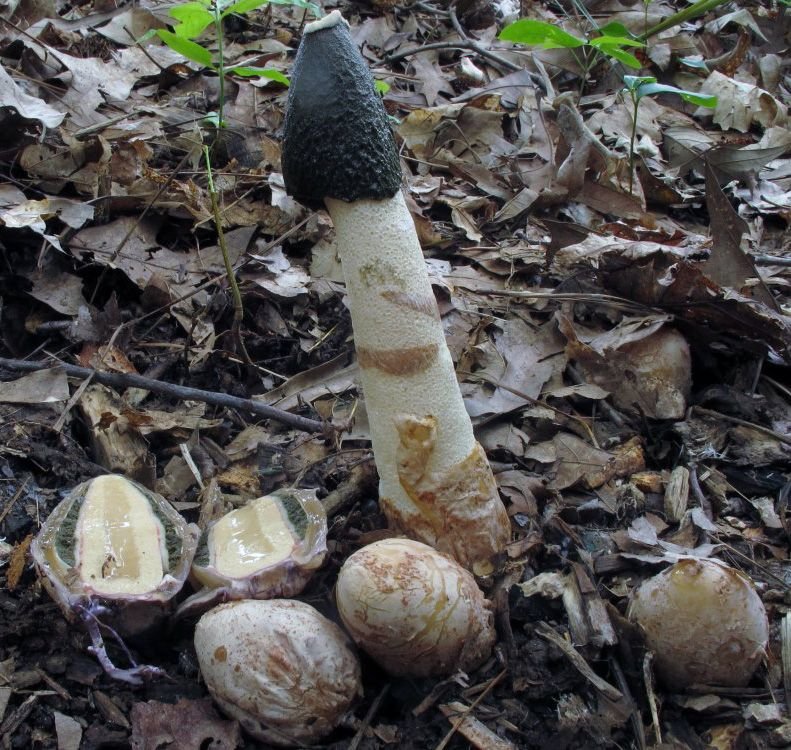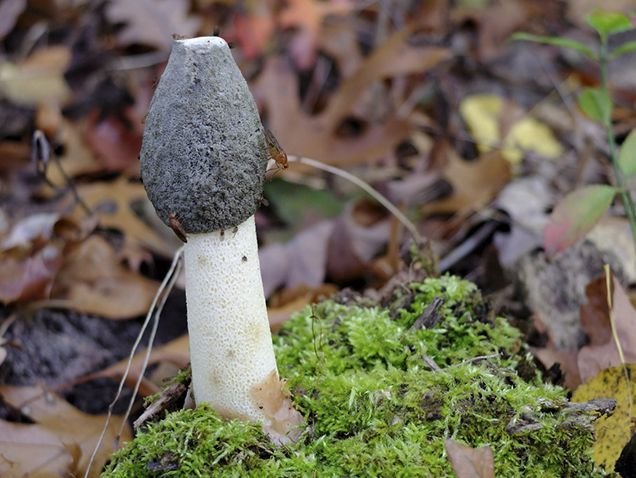Vesyolka Ravenelli (Phallus ravenelii)
- Division: Basidiomycota (Basidiomycetes)
- Subdivision: Agaricomycotina (Agaricomycetes)
- Class: Agaricomycetes (Agaricomycetes)
- Subclass: Phallomycetidae (Velkovye)
- Order: Phallales (Merry)
- Family: Phallaceae (Veselkovye)
- Genus: Phallus (Veselka)
- Type: Phallus ravenelii (Veselka Ravenelli)
- Aedycia ravenelii

Vesyolka Ravenelli (Phallus ravenelii) is a fungus that belongs to the Veselkov family and the genus Phallus (Veselok).
Initially, the shape of Vesyolka Ravenelli (Phallus ravenelii) resembles an egg of pinkish, lilac or purple color. The “egg” develops rapidly, grows in breadth, and as a result, a fruiting body grows out of it, resembling a phallus in shape. The yellowish-white stem of the mushroom is crowned with a hat the size of a thimble. Its width varies from 1.5 to 4 cm, and its height is from 3 to 4.5 cm. The total height of the fruiting body can reach 20 cm. In some specimens, the cap is too wide, and becomes cone-shaped. the color of the cap in different specimens can vary from olive green to dark brown.
The mushroom leg is hollow, it can reach a height of 10-15 cm, and its diameter varies within 1.5-3 cm. In color – white or whitish-yellow.
The spores of Vesyolka Ravenelli (Phallus ravenelii) are characterized by thin walls and a sticky surface, have the shape of an ellipse, smooth, colorless, with dimensions of 3-4.5 * 1-2 microns.
Ravenelli’s Vesyolka (Phallus ravenelii) is widespread in eastern North America. Dominant among other species west of the Mississippi, found in Costa Rica.
The described species belongs to saprobiotics, therefore it can grow in any habitat where rotting wood is present. The fungus grows well on rotten stumps, wood chips, sawdust. Vesyolka Ravenelli can often be seen in groups, but there are also specimens that grow separately. the species is also distributed in urban flower beds, lawns, meadows, park areas, forests and fields.

Ravenelli’s Vesyolki (Phallus ravenelii) are considered edible only at a young age, when they look like an egg. Mature specimens exude an unpleasant odor, so experienced mushroom pickers prefer not to collect them for food.
Ravenelli’s Vesyolka (Phallus ravenelii) is often confused with Phallus impudicus and Phallus Hadriani. P. impudicus differs from the described species in the mesh structure of the cap, the surface of which is covered with alternating grooves and ridges. As for the main difference between the P. Hadriani species, it lies in the presence of stones on the cap. This species, unlike Ravanelli’s merry, can be found very rarely.
Another similar mushroom belongs to the species Itajahya galericulata. It has a spherical cap, the surface of which is covered with several layers of spongy tissue, between which a loose inner tissue, the gleba, is sandwiched.
The next species, similar to the one described, is called Phallus rugulosus. This mushroom is thin, distinguished by its greater height, light orange color of the fruiting body, stem tapering near the cap and the smooth surface of the cap itself. It grows in China, as well as in the southern and eastern parts of the United States.
granulosodenticulatus is a species of Brazilian mushroom that is rare and similar to the ravanelli fungus in its appearance. Its fruiting bodies are smaller and do not exceed 9 cm in height. The cap has a jagged edge, and the spores are large, 3.8-5 * 2-3 microns in size.

Mushroom gleba exudes a characteristic unpleasant odor that attracts insects to the plant. they sit on sticky, spore-bearing areas of the fruiting body, eat, and then carry fungal spores on their paws to other places.









